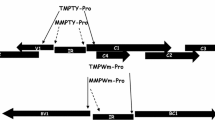Summary
Gene fusions between the β-glucuronidase (GUS) reporter gene and the promoters of the cauliflower mosaic virus 35S RNA transcript (CaMV 35S) and the mannopine synthase (mas) genes were introduced into rapeseed varieties via Agrobacterium-mediated transformation. Fluorometric assay of β-glucuronidase activity indicated different expression patterns for the two promoters.
In seedlings, the CaMV 35S promoter had maximum activity in the primary roots, while the mas promoter was most active in the cotyledons. Etiolated seedlings cultured in the dark showed reduced activity of the mas promoter.
Before vernalization at the rosette stage, both promoters were more active in older plant parts than in younger ones. At this stage the highest activity was recorded in cotyledons.
After the plants had bolted reduced promoter function was detected in the upper parts of the transformed plants. Both promoters were found to be functional in the majority of the studied organs of transgenic rapeseed plants, but the promoter activity varied considerably between the organs at different developmental stages.
The ability of pollen to transfer the introduced genes to other varieties and related species (e.g. Brassica napus and Diplotaxus muralis) by cross-pollination was studied in greenhouse experiments, and field trials were carried out to estimate the distance for biologically-relevant gene dispersal. In artificial crossing, the introduced marker gene was transferable into other varieties of Brassica napus. In field trials, at a distance of 1 metre from the source of transgenic plants, the frequency of an outcrossing event was relatively high (10-3). Resistant individuals were found at 16 and 32 metres from the transgenic pollen donors, but the frequency of an outcrossing event dropped to 10-5.
Similar content being viewed by others
References
An G., 1987. Binary Ti vectors for plant transformation and promoter analysis. Methods in Enzymology 153: 292–301.
Battraw M.J. & T.C. Hall, 1990. Histochemical analysis of CaMV 35S promoter-β-glucuronidase gene expression in transgenic rice plants. Plant Mol. Biol. 15: 527–538.
Benfey P.N., L. Ren & N.H. Chua, 1989. The CaMV 35S enhancer contains at least two domains which can confer different developmental and tissue-specific expression patterns. EMBO J. 8: 2195–2202.
Blaich R., 1992. Function of genetic material: Activity of genes in transgenic plants. Progress in Bot. 53: 207–220.
Boulter M.E., E. Croy, P. Simpson, R. Shields, R.R.D. Croy & A.H. Shirsat, 1990. Transformation of Brassica napus L. (oilseed rape) using Agrobacterium tumefaciens and Agrobacterium rhizogenes—a comparison. Plant Science 70: 90–91.
Bradford M.M., 1976. A rapid and sensitive method for the quantitation of microgram quantities of protein utilizing the principle of protein-dye-binding. Anal. Biochem. 72: 248–254.
Deblaere R., A. Reynaerts, H. Hofte, J.P. Hernalsteens, J. Leemans & M.Van Montagu, 1987. Vectors for cloning in plant cells. Methods in Enzymology 153: 277–304.
Harpster M.H., J.A. Townsend, J.D.G. Jones, J. Bedbrook & P. Dunsmuir, 1988. Relative strength of the 35S cauliflower mosaic virus, 1′,2′, and nopaline synthase promoters in transformed tobacco sugarbeet and oilseed rape callus tissue. Mol. Gen. Genet. 212: 182–190.
Jefferson R.A., T.A. Kavanagh & M.W. Bevan, 1987. GUS fusions: β-glucuronidase as a sensitive and versatile gene fusion marker in higher plants. EMBO J. 6: 3901–3907.
Jefferson R.A., 1987. Assaying chimeric genes in plants: the GUS gene fusion system. Plant Mol. Biol. Rep. 5: 387–405.
Koncz Cs. & J. Schell, 1986. The promoter of TL-DNA gene 5 controls the tissue-specific expression of chimaeric genes carried by a noveltype of Agrobacteriumbinary vector. Mol. Gen. Genet. 204: 393–396.
Langridge W.H.R., K.J. Fitzgerald, C. Koncz, J. Schell & A.A. Szalay, 1989. Dual promoter of Agrobacterium tumefaciens mannopine synthase genes in regulated by plant growth hormones. Proc. Natl. Acad. Sci. USA 86: 3219–3223.
Leung J., H. Fukuda, D. Wing, J. Schell & R. Masterson, 1991. Functional analysis of cis-elements, auxin response and early developmental profiles of the mannopine synthase bidirectional promoter. Mol. Gen. Genet. 230: 463–474.
Nagata T., K. Okada, T. Kawazu & I. Takebe, 1987. Cauliflower mosaic virus 35S promoter directs S phase specific expression in plant cells. Mol. Gen. Genet. 207: 242–244.
Odell J.T., F. Nagy & N.H. Chua, 1985. Identification of sequences required for activity of the cauliflower mosaic virus 35S promoter. Nature 313: 810–812.
Ooms G., P.J.J. Hooykaas, R.J.M.Van Veen, P.Van Beelen, T.J.G. Regensburg-Tüink & R.A. Schilperoort, 1982. Octopine Ti-plasmid deletion mutants of Agrobacterium tumefaciens with emphasis on the right side of the T-region. Plasmid 7: 15–29.
Reiss B., R. Sprengel, M. Willi & H. Schaller, 1984. A new, sensitive method for qualitative and quantitative assay of the neomycin phosphotransferase in crude cell extracts. Gene 30: 211–218.
Rogers S.G., H.J. Klee, R.B. Horsch & R.T. Fraley, 1987. Improved vectors for plant transformation: expression cassette vectors and new selectable markers. Methods in Enzymology 153: 253–277.
Saito K.M., H. Yamazaki, I. Kaneko, Y. Murakoshi, I. Fukuda & M.Van Montagu, 1991. Tissue-specific and stress-enhancing expression of the TR promoter for mannopine synthase in transgenic medicinal plants. Planta 184: 40–46.
Schneider M., D.W. Ow & S.H. Howell, 1990. The in vitro pattern of fire-fly luciferase expression in transgenic plants. Plant Mol. Biol. 14: 935–947.
Stefanov I., S. Fekete, L. Bögre, J. Pauk, A. Fehér & D. Dudits, 1994. Differential activity of the manopine synthase and the CaMV 35S promoters during development of transgenic rape-seed plants. Plant Science 95: 175–186.
Stefanov I., S. Iljubaev, A. Fehér, K. Margóczi & D. Dudits, 1991. Promoter and genotype dependent expression of a reporter gene in plant protoplasts. Acta Biologica Hungarica 42: 323–331.
Trewavas A., 1981. How do plant growth substances work. Plant Cell and Environment 4: 203–228.
Velten J. & J. Schell, 1985. Selection-expression plasmid vectors for use in genetic transformation of higher plants. Nucleic Acids Research 13: 6981–6998.
Author information
Authors and Affiliations
Rights and permissions
About this article
Cite this article
Pauk, J., Stefanov, I., Fekete, S. et al. A study of different (CaMV 35S and mas) promoter activities and risk assessment of field use in transgenic rapeseed plants. Euphytica 85, 411–416 (1995). https://doi.org/10.1007/BF00023974
Issue Date:
DOI: https://doi.org/10.1007/BF00023974




